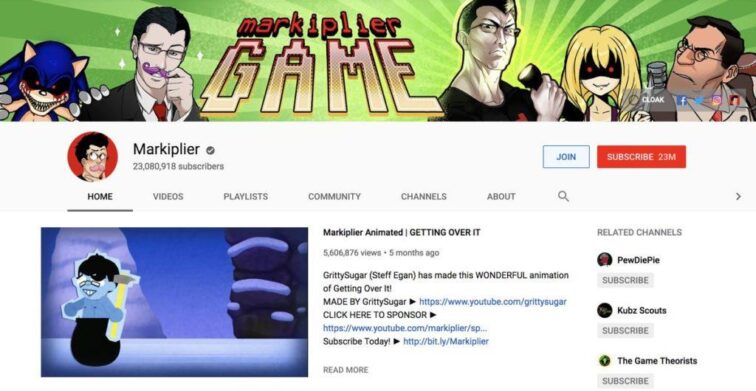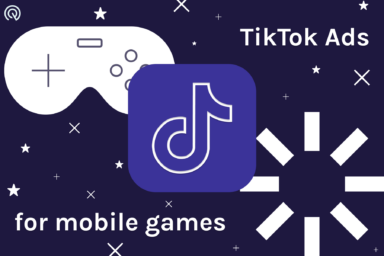Mobile Game Influencer Marketing: A Comprehensive Guide for App Marketers
Getting your mobile game or app noticed becomes more and more challenging. Even if you've already taken steps towards optimizing it with the best ASO practices, seeing a massive increase in users may still prove difficult. That's where mobile app influencer marketing comes into play - it could be just what you need to make progress and gain traction!

However, the success of influencer marketing campaigns hinges on one crucial factor: choosing the right influencers.
In this comprehensive guide, we’ll explore how app marketers can harness the power of influencer marketing to boost app downloads and visibility.
What is influencer marketing?
Let’s start with defining what exactly is influencer marketing.
Influencer marketing uses thought leaders or influencers to spread the word about your mobile app brand or game.
An influencer is anyone with the power to influence their followers’ and fans’ real-life decisions.
There are two main types of influencers:
- A social media influencer is someone who has a large and engaged following on a social platform, such as Instagram, Facebook, Twitter, Twitch, or YouTube.
- A thought leader influencer is someone who is well-known and well-respected in their field of work. They may also have a large social media following.
But, influencers are not only people. Influencers are also social media accounts or online publications that are well-known, well-respected, and well-loved. We are talking about viral meme accounts, addictive streaming channels, and content-filled online publications.

In the end, all influencers have one thing in common: they have influence. Their audience listens to what they say and follows the recommendations they give. Therefore, types of influencers can also be divided based on their number of followers:
- Nano influencers: 1,000 – 10,000 followers
- Micro-influencers: 10,000 – 100,000 followers
- Mid-tier influencers: 100,000 – 500,000 followers
- Macro-influencers: 500,000 – 1M followers
- Mega-influencers or celebrities: 1M+
There are different approaches to working with each type of influencer, but the main difference you will feel in their media kit budgets.
Key benefits of influencer marketing for mobile apps and games
Influencer marketing is a form of word-of-mouth marketing in the digital age. Have you ever had a friend who told you about an excellent mobile game that you have to play? Or have they ever mentioned a super addictive mobile game they can’t stop playing? It is word-of-mouth marketing. You heard about the mobile game from your friend. You trust your friend’s mobile game preferences, so you download the game and begin to play it. Most likely, you’re enjoying the game because you and your friend have similar interests or your friend knows what sort of games you like.
Influencers work similarly. People follow influencers because they are interested in what the influencers are sharing. Travel lovers follow travel influencers. Fashion lovers follow fashion influencers. Game lovers follow gaming influencers. And so on and so forth. People listen to influencers because they trust their recommendations. It’s like getting a recommendation from a friend you’ve known forever. This is true for relatable influencers.
Aspirational influencers influence a bit differently from relatable influencers. People listen to their recommendations because people want to be like them. They’re aspirational. They travel the world, eating good food and taking amazing photos. They wear the best clothes and are always on the front row at exclusive fashion shows. They’re streaming their gameplay night and day, beating levels you can’t imagine getting to.
So, influencer marketing capitalizes on the trust that influencers have built with their audiences. When an influencer recommends a mobile app or game, followers are likelier to take notice and engage. This trust factor can lead to increased downloads, heightened visibility, and improved user engagement.
In addition to these core benefits, let’s explore some additional advantages of influencer marketing for mobile apps and games:
- Social Proof: Influencers provide social proof for your app. When users see their favorite influencer using and endorsing the app or mobile game, it creates a sense of trust and authenticity.
- Content Creation: Influencers often create high-quality, engaging content around your mobile app. It can include tutorials, gameplay videos, and reviews that showcase the app’s features and benefits.
- Targeted Reach: Influencers have carefully curated audiences that align with specific demographics and interests. This targeted reach allows you to connect with users who are more likely to be interested in your mobile app or game.
- User-Generated Content: Influencer campaigns can generate user-generated content (UGC) as followers share their experiences with the app. This organic UGC can be used for social media ads and has proven to be an efficient approach for boosting the app’s visibility.
Read our case study on how language learning app scaled User Acquisition through UGC.
How does influencer marketing work?
Working with an influencer is more work than it may seem at first. But the work really pays off when it’s done right and done well. You can’t pick just anyone and everyone who has a specific influence to collaborate with for your mobile app.
Remember that you need to focus on influencers relevant to your app category or your mobile game niche. Let’s walk you through the steps of how to get started with influencer marketing.
Step 1. Create an ideal persona for your mobile app or game
Your first influencer marketing campaign step is to determine your mobile game’s or app’s target audience. You need to clearly understand who are your ideal users and where they spend time. Try to answer the following questions:
- Who are you targeting?
- What are their interests?
- What channels do they use?
- What products/services do they currently use?
Knowing your user’s behaviors lets you quickly identify who might influence them.
Step 2. Define your target and set up objectives
Influencer marketing can be very creative. Therefore, you need to set your goals and understand which type of influencer marketing you will use in your campaign.
Here are the most common types of collaborations with influencers for mobile games and apps:
- App launch promotion
- Sponsored social media post
- Game or app review
- Promo of game features
- UGC for ads campaign
Depending on your type of collaboration, you also need to understand how you will measure your campaign’s success clearly. Therefore, define your KPIs in the earlier stages of planning the campaign.
Also, having a specific budget in mind would help you to save time reaching out to ‘too expensive’ influencers. If you have an unlimited budget, firstly – lucky you! Secondly, you can either focus on mega-influencers or test different influencer levels to identify the best ROI. However, you probably have a limited budget, and deciding on the right influencers will be the most essential part of your campaign.
Step 3. Choosing the right influencers
Selecting the right influencers is the linchpin of a successful influencer marketing campaign. To make the right choices, consider the following factors:
- Niche Alignment: Your app’s niche should closely align with the influencer’s niche. For example, if your app is a fitness tracking tool, collaborating with a fitness influencer is more effective than partnering with a beauty influencer.
- Audience Demographics: Analyze the demographics of the influencer’s audience. Ensure that their followers match the characteristics of your target audience. This alignment will increase the likelihood of converting followers into app users.
- Engagement and Authenticity: Assess the influencer’s level of engagement with their audience and the authenticity of their content. Authenticity resonates with viewers and can drive more meaningful conversions.
- Reach and Influence: Evaluate the influencer’s reach and the extent of their influence. Micro-influencers with smaller but highly engaged audiences can sometimes be as effective as macro-influencers.
- Past Campaign Success: Research the influencer’s past collaborations and campaign success rates. It can provide insights into their effectiveness as a marketing partner.
- Collaboration Agreements: Establishing clear expectations and agreements with influencers is essential. Define the scope of work, compensation, content guidelines, and any performance metrics. Clarity is key to a successful partnership.
- Long-term Partnerships: Consider building long-term relationships with influencers rather than one-off campaigns. Long-term partnerships can yield more significant results and foster brand loyalty among the influencer’s audience.
Always ask the influencer for their audience demographics and page or channel analytics. Forget the media kit. Ask directly for screenshots from the social platform analytics pages. These include Instagram insights, YouTube analytics, Twitch channel analytics, and more. They’re much more complicated to fake than a media kit. The demographics will tell you where their followers come from, what age range their followers are in, and what percent of their followers are male or female.
Step 4. Prepare influencer brief
Once you have reached out to the list of potential influencers for your campaign for your mobile game or app, it’s time to prepare a brief.
The success of an influencer marketing campaign hinges on the clarity and effectiveness of the influencer brief. An influencer brief is a comprehensive document that serves as a guiding roadmap for both the brand and the influencer. It outlines:
- mobile game or app explanation (what’s your app about),
- campaign objectives (what do you want to reach with this collaboration/ KPIs),
- content expectations (what creative content do you expect to get),
- technical requirements (video duration, video format, etc.),
- deadlines (when you need to get drafts and final versions ready).
To prepare an influencer brief, start by defining the campaign’s core goals: boosting app downloads, increasing brand awareness, or driving user engagement. Next, provide a detailed description of the mobile app or game, highlighting its unique features, benefits, and the problems it solves for users.
Include clear instructions on the content format you expect from the influencer, whether it’s a video review, a tutorial, or a social media post. Specify any brand guidelines, messaging, or hashtags to be used. Collaboration timelines and milestones should also be clearly outlined. To ensure the influencer’s content resonates with their audience, encourage them to infuse their authentic voice and style into their posts. Ultimately, a well-prepared influencer brief lays the foundation for a successful partnership and helps influencers understand their role in achieving the campaign’s objectives.
Remember that each influencer has its own style, and you shouldn’t limit their creativity with your strict brief. They probably won’t even agree on the strict creative guidelines or produce content that won’t reflect in their audience. Let influencers be themselves. Usually, long-term successful collaborations are based on trust and straightforward expectations.
Step 5. Analyze influencer marketing campaign results
Once an influencer marketing campaign is executed, it’s essential to analyze its results meticulously to gauge its impact and ROI. Start by examining key performance indicators (KPIs) set in the influencer brief. Compare your metrics to baseline data before the campaign to assess the uplift achieved. Additionally, use App Radar’s AI Review Summaries to analyze user reviews and ratings on app stores for any noticeable changes during and after the campaign period.
Calculate the campaign’s return on investment (ROI) by comparing the cost of the campaign to the revenue generated, taking into account the increased app downloads and user actions attributed to the campaign. This analysis helps measure success and informs future influencer marketing strategies, allowing brands to refine their approach for even better results.
Top 3 Influencer marketing campaign strategies for mobile apps and games:
Now that you understand how Influencer Marketing works, let’s delve into specific influencer marketing campaign strategies for mobile games and apps:
1. App Launch Campaigns
Collaborating with influencers can create a buzz and generate early interest when launching a new app. Here’s how to approach an app launch campaign:
- Teasers and Countdowns: work with influencers to build anticipation by creating teaser content and countdowns leading up to the launch.
- Live Demonstrations: host live streams or webinars with influencers showcasing the app’s features and answering questions from the audience in real-time.
- Exclusive Access: provide influencers early access to the app or exclusive features, which they can share with their followers.
2. App Reviews and Tutorials
Influencers can provide in-depth reviews and tutorials to help users understand your app better. These can be highly effective in demonstrating how the app solves a problem or enhances the user’s life:
- Step-by-Step Tutorials: influencers can walk through the app’s functionality and provide tips on how to use it effectively.
- Highlight Unique Features: ask influencers to highlight the app’s unique features that set it apart from competitors.
- User Testimonials: encourage influencers to share user testimonials and success stories related to the app.
3. User-Generated Content Campaigns
Engage influencers and their followers to create user-generated content related to your app:
- Challenges and Contests: launch challenges or contests where users can showcase their experiences with the app. Influencers can help promote these initiatives.
- Hashtag Campaigns: create a branded hashtag for your app and encourage users to share their content using it.
Challenges and pitfalls in influencer marketing for mobile games and apps
While influencer marketing for apps offers numerous benefits, there are also challenges and pitfalls to be aware of:
- Inauthenticity: if influencer partnerships feel forced or inauthentic, it can lead to negative feedback from users.
- Compliance and Disclosure: ensure influencers disclose their partnerships transparently to maintain trust and comply with relevant advertising regulations.
- Vetting Influencers: failing to thoroughly vet influencers can result in misaligned partnerships or influencers with fake followers.
- Measurement Complexity: measuring the ROI of influencer marketing can be complex, and inaccurate tracking may lead to misjudging campaign effectiveness.
- Budget Management: managing influencer marketing budgets can be challenging, as costs vary widely depending on the influencer’s reach and reputation.
Short Summary
Influencer marketing is a potent tool for app marketers looking to boost app downloads and visibility. However, its success depends on careful influencer selection and strategic campaign planning. By aligning your app’s niche and target audience with the right influencers and employing the campaign strategies outlined in this guide, you can harness the full potential of influencer marketing and drive tangible results in the competitive world of mobile apps.
In an era where user trust and engagement are paramount, influencer marketing offers a unique opportunity to connect with your target audience on a personal level and create lasting brand impressions. As you navigate the evolving landscape of app marketing, remember that influencer marketing is not just about reaching more users; it’s about forging genuine connections that drive app growth and loyalty.
Explore the diverse world of influencers, experiment with different campaign types, and continuously refine your influencer marketing strategies to stay ahead in the dynamic realm of mobile apps. With the right influencers by your side, your app can thrive and stand out in a crowded marketplace.
Need Help Growing Your Apps?
Get in touch with our app marketing growth team to discuss the right solutions for your mobile app business

Latest Posts


